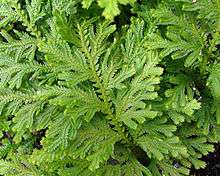Selaginella moellendorffii
Selaginella moellendorffii is a lycophyte that is an important model organism, especially in comparative genomics. S. moellendorffii is a member of an ancient vascular plant lineage that first appeared in the fossil record some 400 million years ago. They would later form a dominant part of the world's flora during the Carboniferous period. These lycopsids lack true leaves (having microphylls instead) and roots and thus represent an important node on the plant evolutionary tree. As the earliest diverging group of modern vascular plants, they are essential to understanding the evolution of plants as a whole.
| Selaginella moellendorffii | |
|---|---|
 | |
| Scientific classification | |
| Kingdom: | Plantae |
| Clade: | Tracheophytes |
| Clade: | Lycophytes |
| Class: | Lycopodiopsida |
| Order: | Selaginellales |
| Family: | Selaginellaceae |
| Genus: | Selaginella |
| Species: | S. moellendorffii |
| Binomial name | |
| Selaginella moellendorffii Hieron. | |
Genome sequencing
The nuclear genome size is approximately 100 mega base pairs, one of the smaller genome size found for any plant species. The genome has been sequenced and assembled by the United States Department of Energy's Joint Genome Institute.[1] Community annotation of the genes and other elements of this genome began in September 2007. Gene content of Selaginella moellendorffii and diverse taxa, have showed that the transition from gametophyte to sporophyte dominated life cycle entailed the addition of fewer new genes than the move from nonseed vascular plants to angiosperms.[2]
References
- Selaginella moellendorffii v1.0, DOE Joint Genomics Institute, 2007, retrieved 2008-02-26
- Banks, Jo Ann; Nishiyama, Tomoaki; Hasebe, Mitsuyasu; Bowman, John L.; Gribskov, Michael; dePamphilis, Claude; Albert, Victor A.; Aono, Naoki; Aoyama, Tsuyoshi (2011-05-20). "The Selaginella Genome Identifies Genetic Changes Associated with the Evolution of Vascular Plants". Science. 332 (6032): 960–963. doi:10.1126/science.1203810. ISSN 0036-8075. PMC 3166216. PMID 21551031.
External links
- American Society for Plant Biology Selaginella education page
- Selaginella genomics website - contribute to the genome annotation
- Purdue University's Selaginella Wiki